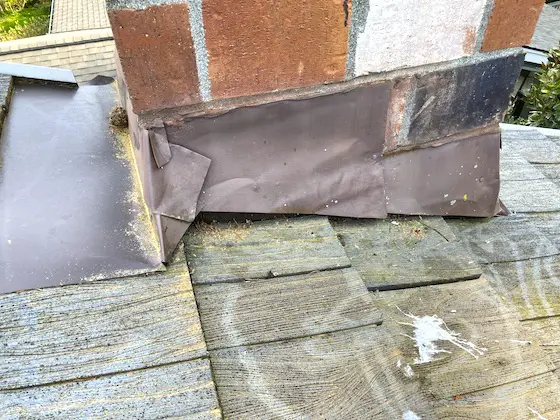How to Find a Roof Leak

How to Find a Roof Leak | While this metal chimney flashing looks worse for wear and design, it does a fine job and prevents water from leaking around the brick chimney. Copyright 2022 Tim Carter
How to Find a Roof Leak
Several weeks ago I shared with you the different types of roofs you can use on your home. I should have realized it would create a tsunami of help requests regarding roof leaks at my Ask Tim page on my www.AsktheBuilder.com website.
You may have been one of the many who have roof leaks that local roofers have not been able to fix or maybe an unskilled laborer was went up on your roof with a caulk gun loaded with black goo. Today I’m going to do my best to share with you the locations of almost all roof leaks and how simple it is to prevent them or fix them.
Just about any professional roofer will agree that roof flashing is at the center of the vortex of just about every leak. If you’ve never been up on a roof, most homeowners haven’t, then you might wonder what is roof flashing?
What are Roof Flashings?
I feel the best definition of roof flashings is they are transitional materials that connect a roof to something that’s not a roof. Here’s a partial list of things that are not a roof:
- plumbing vent pipe
- chimney
- skylights
- powered roof ventilator
- attic or room dormer
- a wall that’s next to and rises above a roof
At each of the above locations you need to ensure water will not enter around the thing popping up through or immediately adjacent to the roof. Master roofers centuries ago solved this problem. Castles, cathedrals, and common homes had flashings most made from common malleable metals such as lead or copper.
Is Lead a Good Flashing Material?
If you paid attention to the news stories after the tragic fire at the 2019 Notre Dame Cathedral in Paris, you know that the ruins were considered a toxic waste site because of the tons of lead that had become part of the ruins. Vast amounts of sheet lead was used hundreds of years ago as flashing at countless places up on that roof.
Do Roof Leaks Happen Away from Flashings?
It’s possible, although very rare, to have a leak in the field area of a roof far away from flashings. I did a phone consult with a man a month ago. Within minutes I had him locate the source of his leak. He saved hundreds of dollars using my advice.
The good news is it’s simple to install most roof flashings. If I came to your city or town and did a half-day clinic, I would be able to train you how to install most common flashings in just a few minutes. Yes, it’s that simple.
Many roof flashings are available that are far superior to others. I’ve been using a superb plumbing vent pipe flashing for years that outperforms the cheaper flashing most roofers and plumbers put on your home. The flashing base is made from heavy-duty powder coated metal and the flexible boot is made from a silicone-rubber material that resists ultraviolet (UV) rays that destroy the cheaper flashing in just a few years.
Who Makes the Best Skylight Flashings?
A well-known skylight manufacturer provides their own aluminum flashings with each skylight. These are so simple to install anyone who can fog a mirror can do it. The best part is the flashings are so well engineered they don’t leak even in harsh storms. If you live in a cold climate where ice and snow can build up on your roof, it helps to install an ice and water barrier material up against the sides of the skylight before you install these factory-made flashings.
What are Tin Flashings?
Years ago tin-coated steel was the flashing material used by professional roofers. It came in different weights with 20 and 40-pound tin coating being the most popular. Sadly government regulations have prohibited you from using this fantastic product. To get the same results and ease of installation, you need to use expensive copper.
What are the Best Flashings?
The best flashing materials in my opinion, and time has proven this, are those you can solder. Certain flashing connections have to be folded and interlaced. This metal origami creates tiny holes where two flashing meet that must be soldered to provide a leak-proof installation for decades. I can take you up onto roofs of old homes in the Northeast and Midwest where soldered flashings are still in excellent condition having been exposed to nearly 100 years of weather. Caulk would never produce this result.
Is Caulk a Good Roofing Material?
If your roofer tells you he’s going to use caulk, suggest to him you’d like to pass on that option. Caulks can be damaged by the sun’s UV rays and break down. Those roofers that swear high-performance caulk will provide no leaks must use expert skills to get the caulk to bond to all the flashings and the things the flashings touch. Will the employee who’s up on your roof have these skills?
I’ve assembled quite a few videos that demonstrate to you how flashings should be installed. These videos can help you communicate to a roofer what you want done to ensure you and your possessions stay dry. Watch the flashings videos here.
Column 1459